A self-guided progressive dining experience through Gilroy’s historical landmarks
If you love local history and delicious food, we’ve got a great Gilroy experience for you!
With our self-guided progressive dining experience, you can take a culinary trip back in time while you enjoy some of the very best food here in Gilroy, the Garlic Capital of the World. Spice up your visit by turning it into a combined educational and culinary experience to share with your favorite foodies.
For the full experience, allow plenty of time to visit all four unique restaurants in some of Gilroy’s oldest buildings, each with an interesting, colorful past. All the restaurants are within a short walk of each other in Gilroy’s historic downtown.
Before You Go: This blog is your history guide, so keep a digital or printed copy with you. Visit each of the restaurants below to see some of this history up close. At each stop, read about the building’s unique architecture and intriguing past while you enjoy your drink, appetizer, or other delicious dishes. See how much of Gilroy’s downtown history you already know—and learn some interesting things that may surprise you.
Since this tour is self-guided, you can plan it in a way that’s most convenient for you and your foodie companions. You can mix it up or split it into two outings, creating your own customized, historical dining experience. View our Historical Dining Tour Getaway page for inspiration.
Gilroy Historical Dining Stop #1: Tempo Kitchen & Bar
7560 Monterey Rd., Gilroy, CA
Today:
Tempo Kitchen & Bar is a music-themed restaurant with modern American cuisine and handcrafted cocktails. For the grand opening in November 2021, Dan and Nancy Nelson transformed the building into a unique space with wood-paneled walls adorned with vinyl records and musical instruments. Each weekend they have live music, and they host weekly Winemaker Dinners featuring local or California state wines, along with other themed events.
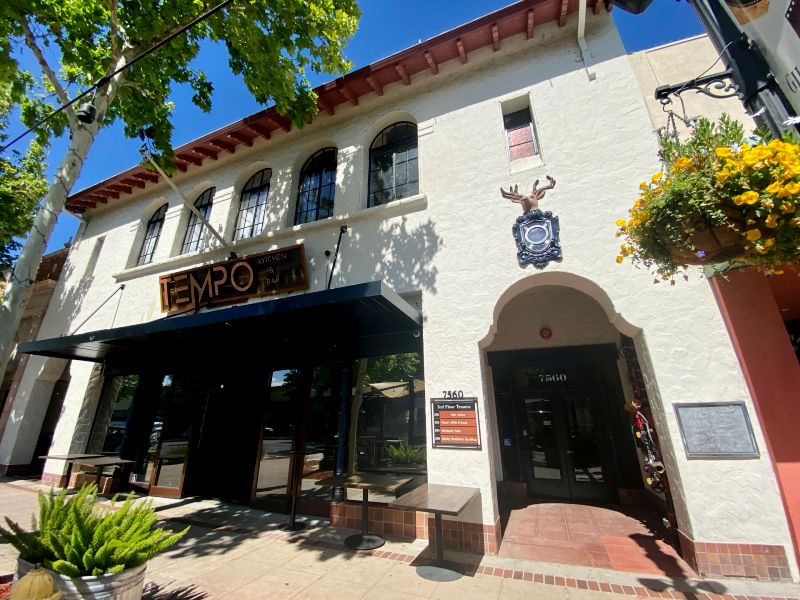
In the Past:
Known formerly as the “Elks Building,” this Spanish colonial revival style building was originally designed by architect Albert Roller and built by William Radtke in 1931 for the Gilroy Elks Lodge. The original arched windows along the top of the façade and double ornate wooden posts by the entrance remain intact. Over the arched doorway outside, you can see an elk’s head with a shield above the arched upstairs entrance. A framed marble plaque commemorates the building as a gift from Lin W. Wheeler, owner of Pieters-Wheeler Seed Company, to his Elks brothers of #1567.
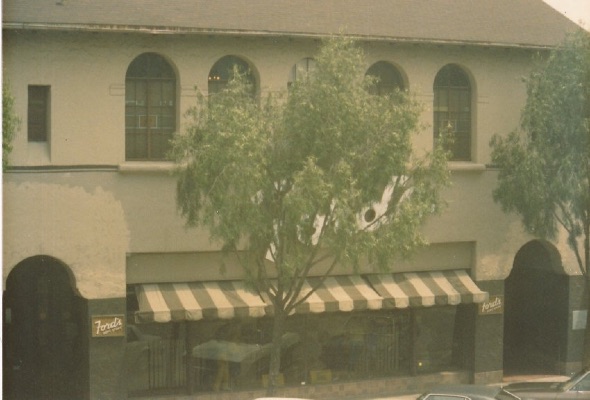
While the Elks met upstairs, the downstairs housed several furniture stores, including Barshinger’s, until 1979. Then the whole building was sold to Ford’s Department Stores, which is the oldest department store chain in California. Because the building was made from poured concrete, it was one of a few buildings that did not need to be retrofitted in recent years when laws made that a requirement for older structures that were built from brick. Prior to Tempo Kitchen & Bar, the building housed Golden State Brewery, whose owners added the outdoor seating area along Monterey Road.
Gilroy Historical Dining Stop #2: Station 55 Seafood & Mexican Cocina
55 Fifth St. Gilroy, CA
Today:
Station 55 Seafood & Mexican Cocina is a Mexican restaurant and bar that specializes in traditional Mexican cuisine made with premium ingredients artfully prepared by master chefs. Diners enjoy excellent customer service as well as exceptional and authentic food at an affordable price.
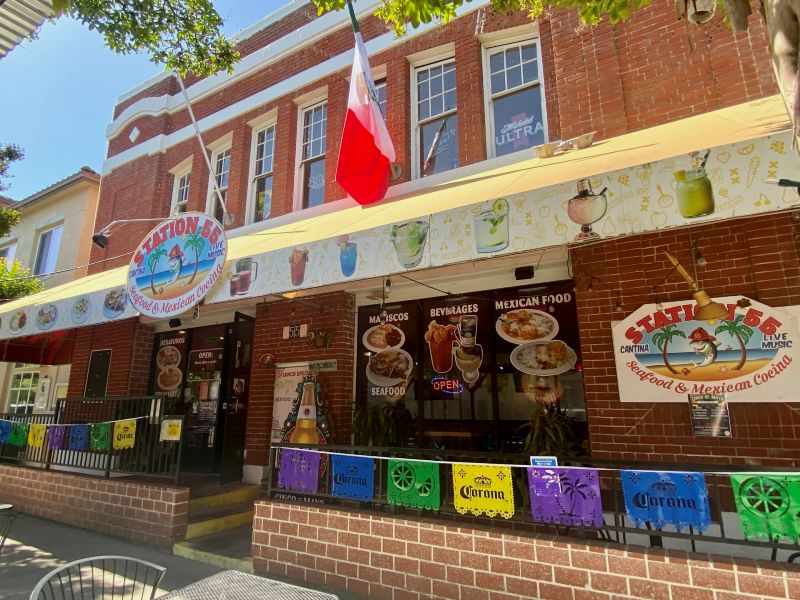
In the Past:
As its name implies, Station 55 (“The Old Firehouse”) was originally a fire station built in 1916 to serve the city of Gilroy. The fire house was designed by San Jose architect William Binder and constructed by William Radtke. It is a two-story brick building with a flat roof and a distinctive row of windows shaped to form a semicircular arch across the entry. This building housed a few restaurants over the years, and it was retrofitted in 1980s.
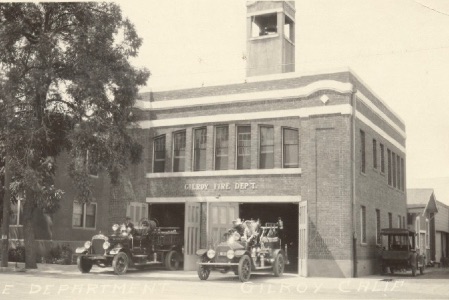
Gilroy Historical Dining Stop #3: The Milias Restaurant
7397 Monterey St. Gilroy, CA
Today:
The Milias Restaurant is an American-style restaurant serving a variety of dishes, often inspired by seasonal foods. Adam Sanchez and Ann Zyburra opened The Milias Restaurant in 2011. Their motto, “Take a Step Back and Dine,” is obvious throughout their entire establishment. They kept the original floor made of hand-cut marble tiles in a herringbone pattern, the crown-molded ceiling, and the trademark horseshoe-shaped bar. Adam and Ann also have also a variety of historic pieces, several from the original building, spread throughout the space.
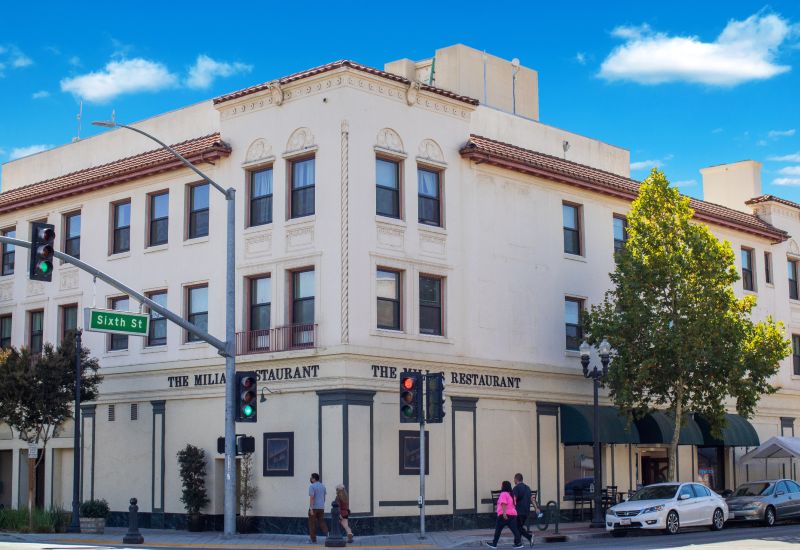
In the Past:
The Milias Restaurant was originally designed by William Weeks and built by James Patterson in 1922 for $200,000. Designed in a Spanish Revival style, it was built to be a hotel, with a basement, three floors, 60 rooms, and a garden roof that was used for dining and dancing. Off the roomy entryway was a grand double dining room, and on the fourth floor, a bright, airy space referred to as “The Sun Room” was also used for dining and dancing. The Milias Hotel was the first three-story building in Gilroy, and the elevator installed in this hotel—the first in the city—was quite the novelty in the community at the time, especially to local kids.
Noticeable architectural touches include the scrollwork on the sides of the building and the arches with embossed decorations over the front entrance windows. The Spanish Revival style is also evident in the spiral column on the Monterey Street side and wrought-iron balconies on some windows.
George Milias, Sr., the owner, first came to Gilroy from Yugoslavia and operated another café and hotel on the site called the William Tell House. He also ran the Milias Chop Shop in 1895. It was after the addition of the Monterey Highway (then a brand-new Highway 101) right through Gilroy that George Milias, Sr. seized the opportunity to tear down the Chop House and convert his business to the The Milias Hotel and The Milias Restaurant and Steakhouse.
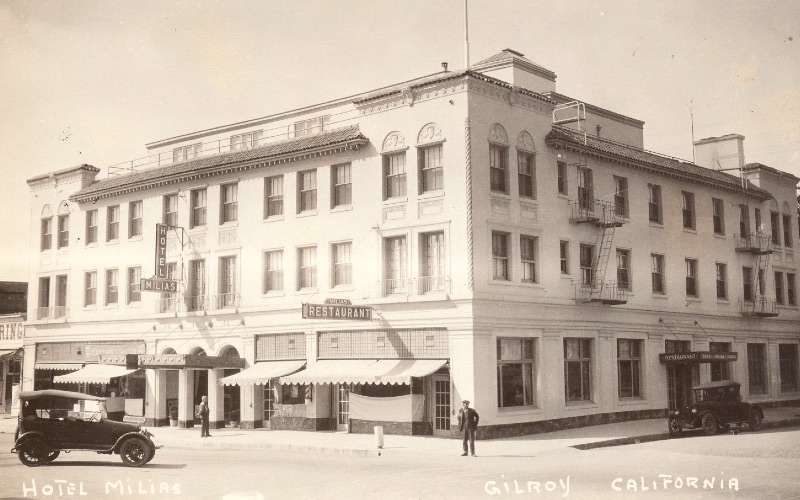
The Milias became the place to be during Gilroy’s “Cowboy Era.” Members of the Gilroy Gymkhana Committee, an active rodeo group from 1929-1956, gathered here. Hall’s Western Wear was conveniently located just across the street, and George Milias himself owned his own cattle ranch on Pacheco Pass. The cowboy mural over the bar depicts this era.
George Milias, Sr. and his wife inhabited a second-floor apartment for many years. Their son, George Milias, Jr., ran the hotel after them and served as a mayor for Gilroy for several years. The third-generation George Milias even served as a state assemblyman. When the current Highway 101 bypassed Gilroy and Monterey Highway was no longer the main thoroughfare from Los Angeles to San Francisco, the restaurant changed hands, and the hotel rooms were converted into apartments.
The Milias has hosted many famous guests and diners over the years, including Will Rogers in 1934, Clark Gable twice in 1945 (with a “mysterious blonde”), Bing Crosby, Frank Sinatra, Abbot and Costello, Carole Lombard, and John Wayne, who visited several times as he raised cattle at a nearby ranch. The Milias’s central location between Hollywood and San Francisco made it the perfect stop for celebrities passing that way.
Gilroy Historical Dining Stop #4: Old City Hall Restaurant
7400 Monterey St. Gilroy, CA
Today:
Old City Hall Restaurant is in one of downtown’s most iconic landmarks and serves a variety of menu items, including many garlic dishes. Popular with both visitors and locals, the venue often hosts karaoke nights, line dancing upstairs, themed events, and a variety of special events in the reserveable upstairs room.
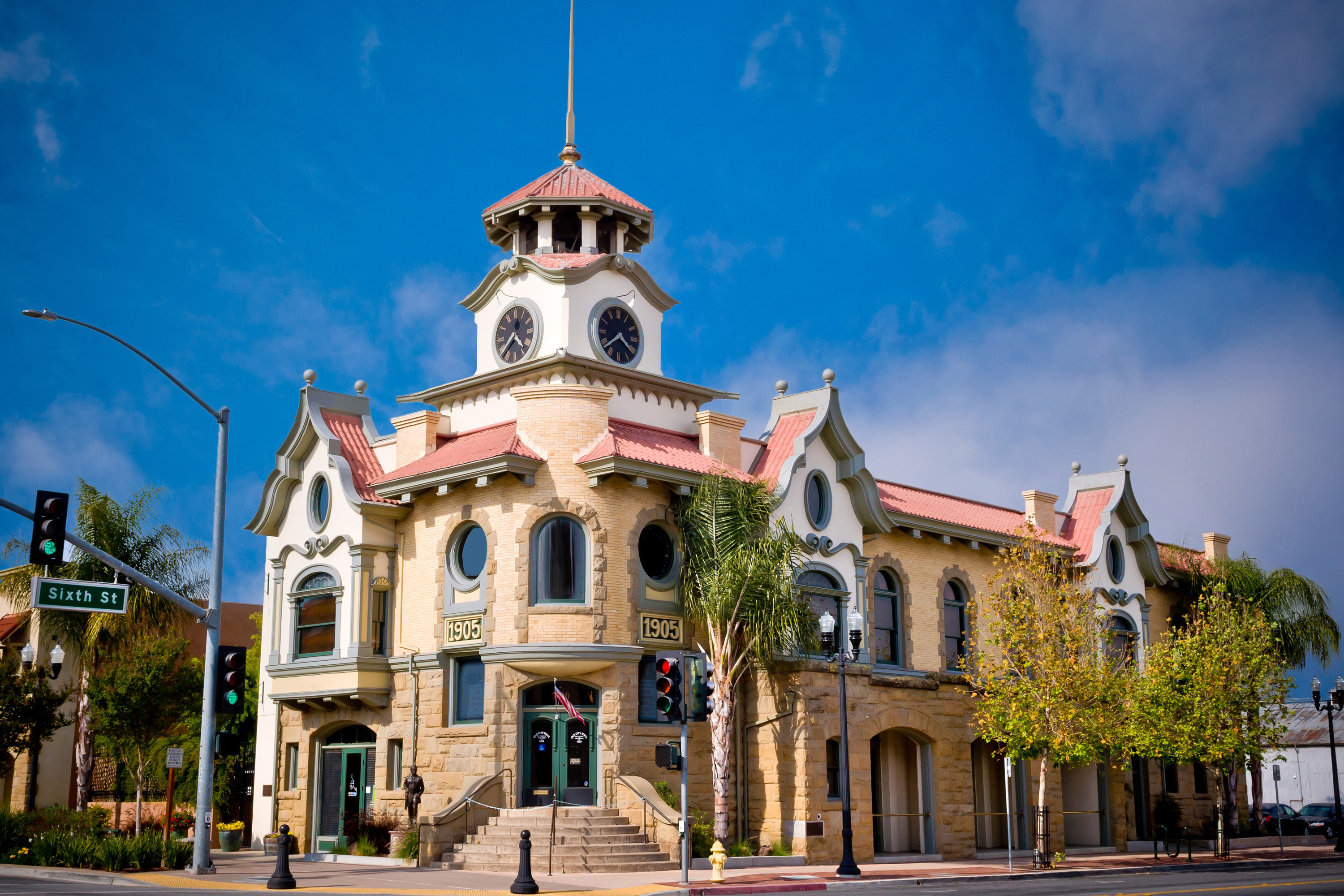
In the Past:
The Old City Hall building was first built in 1905 by Granite Rock. Co., and it was designed by architects Wolf & McKenzie in a Flemish Revival/Spanish Baroque style. Look for the framed construction blueprints in the hallway between the front door and the bar. The sandstone on the first story came from the Glen Ranch south of Gilroy as a gift from the “Cattle King” Henry Miller. The second story is made of brick and stucco over wood framing. The two stories were originally built as separate parts, and the upstairs was entered by the stairs outside at the corner of Monterey and Sixth Street.
The most prominent feature of this building is the tile-covered bell and clock tower with a finial on top. Before entering the building, see if you can spot the Seth Thomas clock in the curved window over the corner stairs. A widow named Caroline Hoxett donated it in 1912, and it must be wound twice a week.
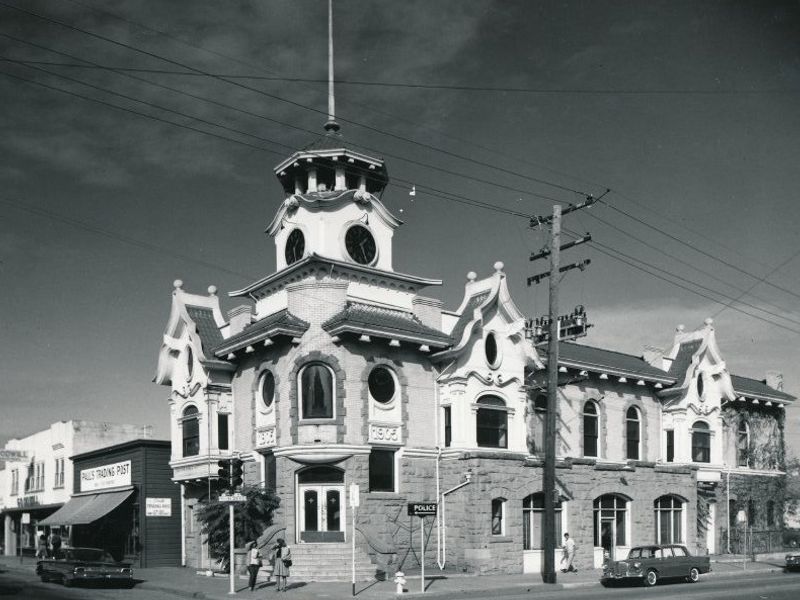
As the name suggests, this building was used by the City of Gilroy as City Hall for over fifty years. It was also occupied by the fire department and the police at different times. Be sure to check out the restrooms—they are located inside the former jail cells!
You can also see the City’s original safe, where the City Clerk would put citizens’ payments for their water or taxes. It is now the wine cellar.
When it the building was used as City Hall, the judge’s chambers were in the upstairs room by the bay window. When the fire station was housed here, the doors for the engines went out onto Sixth St.; those were later converted into windows. Behind the building there is a two-story shaft that was used to dry the fire hoses.
The Old City Hall building, used by the city until circa 1958, was supposed to be demolished in 1966, but it was saved by the Gilroy Historical Society and added to the National Register of Historic Places by 1972. After heavy damage by the Loma Prieta Earthquake, a renovation was completed by 1994. The building has housed a variety of restaurants since then.
Other Historical Highlights
For other interesting ways to explore Gilroy’s varied and intriguing history, visit the Gilroy Museum, check out our blog: History Highlights in Gilroy, or explore our historical downtown with our map Downtown Gilroy Self-Guided Walking Tour .
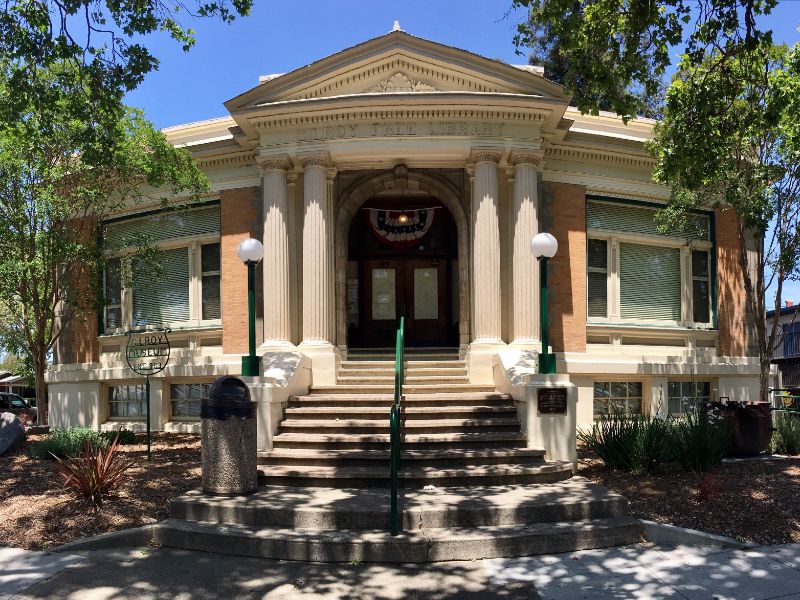
The Gilroy Museum
You can also join one of the monthly walking tours (held on the first Saturday of most months) hosted by docents of the Gilroy Historical Society—for more info, see the Events Calendar.
Gilroy has so much interesting history to explore and so many other fun things to do, you will need a few days to do it all! Book yourself a stay at one of our affordable Hotels, and choose from our 33 Things to Do In and Around Gilroy.
While you’re here, be sure to stop by the California Welcome Center Gilroy in the Gilroy Premium Outlets (near Forever 21) to learn more from our friendly staff about all that Gilroy has to offer.
A big thank you to Connie Rogers and Susan Voss of the Gilroy Historical Society and the Gilroy Museum for providing some content and historical photos for this blog.


